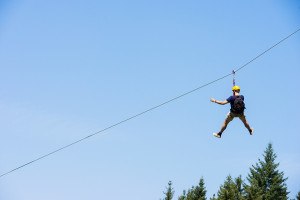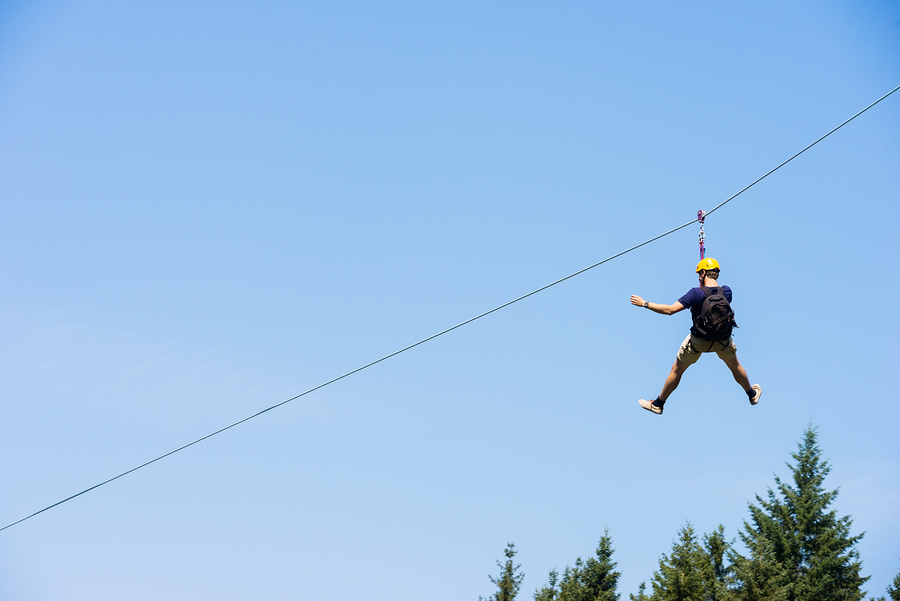The number of commercial ziplines in the U.S. rose from 10 in 2001 to more than 200 in 2012, according to a study released last year by researchers at the Center for Injury Research and Policy part of The Research Institute at Nationwide Children’s Hospital.
That’s in addition to the more than 13,000 amateur ziplines found in outdoor education programs, camps, and backyards.
 With increasing popularity comes increasing injury, according to the study which found an estimated 16,850 non-fatal zipline-related injuries were treated in U.S. emergency departments from 1997 through 2012.
With increasing popularity comes increasing injury, according to the study which found an estimated 16,850 non-fatal zipline-related injuries were treated in U.S. emergency departments from 1997 through 2012.
Because nearly 70 percent of the injuries occurred within the last four years of the study period, there is concern of a growing problem. The study revealed that in 2012 alone, there were more than 3,600 people treated in U.S. emergency departments for zipline-related injuries, nearly 10 per day. More than 90 percent of the injuries occurred April through October, with the number of injuries peaking in July.
Published online and in the American Journal of Emergency Medicine, the study found that falls accounted for more than three-quarters (77 percent) of zipline-related injuries followed by collisions (13 percent), including those with tree and other anchor structures.
The most frequent types of injuries that occurred as a result of ziplining included broken bones (46 percent), bruises (15.2 percent), strains/sprains (15.1 percent), and concussions/closed head injuries (7 percent). Eleven percent of patients were admitted to the hospital for their zipline-related injury.
“Though the rate of injuries while ziplining is relatively low, when injuries do occur they can be quite serious,” said Tracy Mehan, MA, manager of translational research for the Center for Injury Research and Policy at the Research Institute at Nationwide Children’s and one of study’s authors. “The high rate of hospitalization is consistent with what we see for adventure sports and reflects the severity of the injuries associated with this activity.”
Children younger than 10 years of age accounted for almost half (45 percent) of the zipline-related injuries while youth, ages 10-19, accounted for an additional 33 percent of injured patients.
Many injuries reported in the study were associated with ziplines located at sport and recreation facilities, such as outdoor education centers, challenge courses, canopy tours, summer camps and parks. Although ziplines are often open for use by the public, they are not regulated in many states and may not meet industry standards. Self-regulated zipline operations represent an unaddressed potential hazard to the public, the study authors said.
“Currently, there are a number of national organizations with their own safety guidelines and standards for ziplines, and which of these guidelines and standards are applied to zipline operations varies among states and even among jurisdictions within a state” said Gary Smith, MD, DrPH, the study’s senior author, director of the Center for Injury Research and Policy at Nationwide Children’s and professor of pediatrics at The Ohio State University College of Medicine. “Commercial ziplines and non-commercial public-accessible ziplines should be subject to uniform safety standards in all states and jurisdictions in the US to help ensure safety.”
Researchers warn against do-it-yourself zipline kits and specific components (wires, harnesses, etc.) which are available for purchase online for private use.
“Due to the inherent risks associated with homemade ziplines, parents, caregivers, and children should not install and use ziplines at home,” said Mehan. “Improper installation, maintenance, or use of homemade ziplines can result in serious injuries and even death.”
Proper zipline safety equipment includes harnesses, helmets and gloves.
Was this article valuable?
Here are more articles you may enjoy.


 CBS Poised to Lose Bid to Stop Sony Taking ‘Jeopardy’ Rights
CBS Poised to Lose Bid to Stop Sony Taking ‘Jeopardy’ Rights  Ireland and UK Face High Wildfire Risks After Dry, Warm Weather
Ireland and UK Face High Wildfire Risks After Dry, Warm Weather  Plane Carrying New York Lawmakers Clipped at Reagan Airport
Plane Carrying New York Lawmakers Clipped at Reagan Airport  NYC Tourist Helicopter Crashes in Hudson River, Killing Six
NYC Tourist Helicopter Crashes in Hudson River, Killing Six 